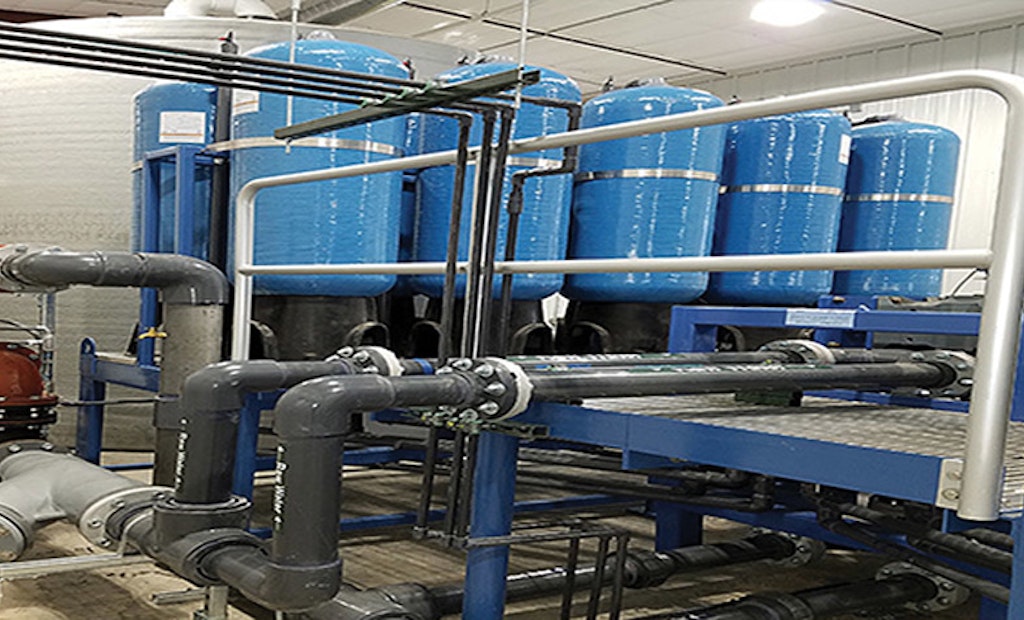Interested in Odor Control?
Get Odor Control articles, news and videos right in your inbox! Sign up now.
Odor Control + Get AlertsContinuous ion exchange technology utilized to combat rising nitrate levels
Problem
The city of Bayard, Nebraska was experiencing rising nitrate levels in their water and made the decision to pre-purchase a water treatment system to address the nitrate concerns. In addition to the nitrate levels, they also had constraints on their discharge and were unable to discharge to the sewer. This was going to require the acquisition of additional land to dig waste lagoons.
Solution
Tonka Water, a Kurita America Brand’s Pur-IX system was selected due to its minimal waste and reduced salt usage. The reduced waste output also allowed for the city to keep the land requirement to a minimum, further reducing costs. The system applies conventional ion exchange treatment through an innovative process, allowing for a smaller footprint while ensuring the lowest waste volume. It incorporates 20 continuously operating ion exchange vessels, 14 of which are treating water in unison, while the remaining six vessels are regenerating. The system continuously cycles out-of-service vessels through an efficient multi-step regeneration process, automatically returning regenerated vessels back into service. Operating this way ensures the ion exchange resin is being utilized to its maximum capacity, providing the highest level of efficiency. It generates a single continuous low flow waste stream, eliminating the need for enhancements such as waste equalization, gradual “bleeding” to final discharge, large evaporative pond waste handling systems, or shock loading to wastewater plants.
Result:
The Bayard plant is performing well and has been meeting expectations since commissioning in 2018. 866-663-7633; www.kuritaamerica.com

Oxygen injection system answers odor concerns
Problem
A 9,000-foot-long force main at the Granby RV Park in Granby, Colorado, was going septic, causing a huge odor problem in a pristine area 30 miles south of Rocky Mountain National Park. In the mountain location, frigid weather sometimes made it difficult for field technicians to work on issues. There were plans for a 300-unit residential development nearby, making odor reduction all the more important.
Solution
The FORSe oxygen injection system with remote digital telemetry (Anue Water Technologies) was tested for six months and ultimately chosen. It replaces chemical treatment and related operating requirements. The system has capability to inject ozone or a combination of oxygen and ozone. The remote digital telemetry makes it safe and easy for operators to monitor and control dissolved oxygen levels. Technicians at Anue Water can also log in and monitor.
Result:
The system eliminated the odors, bringing hydrogen sulfide levels nearly to zero. The system is paying for itself in chemical and operating cost savings. Operators can monitor and control remotely, important during winter and under the COVID-19 pandemic. 760-727-2683 www.anuewater.com

System clears the air at municipal pumping station
Problem
Odors around two municipal pumping stations in L’Assomption, Quebec, compromised quality of life for residents. Hydrogen sulfide and mercaptan odors were concentrated at times throughout the day. Oils and grease in the foul air stream also had to be.
Solution
Newterra supplied two deep-bed scrubber systems with properly sized fans and prefiltration units for mist and grease removal. Each vessel was filled with high-yield carbon to target the odors.
Result:
Odor removal was greater than 99.95%, leaving an undetectable odor level at the outlet side of the units. The air phase scrubber systems were installed within a few hours and have required minimal maintenance. 800-420-4056; www.newterra.com

Plant achieves 99.9% hydrogen sulfide removal
Problem
The 75 mgd Blue River Wastewater Treatment Plant in Kansas City, Missouri, needed to meet high odor removal efficiency requirements.
Solution
The city deployed a dual-stage BTF-Bioscrubber biological odor control system from Evoqua Water Technologies. The advanced, non-hazardous air treatment system includes structured and randomly packed biological media and integrates equipment, media and a NUCIRC process for optimal performance and flexibility. The process skid can operate in recirculation or once-through modes.
Result:
During testing, the system consistently achieved 99.9% reduction in hydrogen sulfide while removing of organic sulfur compounds such a methyl mercaptan, dimethyl sulfide, carbon disulfide and dimethyl trisulfide. The single vessel treated a foul airflow of 14,000 cfm with no increase in pressure differential. 844-409-9492; www.evoqua.com

City uses software to mitigate odor and improve community relations
Problem
The Kalamazoo (Michigan) Water Reclamation Plant faced odor complaints from the community. The solution needed to consider potential hydrogen sulfide sources on- and off-site.
Solution
The city implemented EVS Omnis from EnviroSuite. The program enables real-time monitoring and visualization of hydrogen sulfide data and provides alerts for exceedances. Reverse trajectory modeling helps identify the sources of odor complaints. Predictive odor modeling helps assess potential emissions during high-risk periods.
Result:
The staff gained better situational awareness and was better positioned to investigate and resolve odor complaints. They have identified potential emission sources and can analyze their contributions to air quality. 424-335-1331; www.envirosuite.com

Plant upgrades ozone contacting system
Problem
The Orlando (Florida) Utilities Commission’s 45.6 mgd Southwest Water Treatment Plant’s needed to upgrade an ozone system used ozone for disinfection and to convert hydrogen sulfide in well water into sulfate, solving a taste and odor challenge.
Solution
Three fine-bubble diffuser contact basins were replaced with a sidestream injection system using five venturi injectors with a Pipeline Flash Reactor from Mazzei Injector Company. The change streamlined operations and enabled turndown without sacrificing efficiency or control of precise ozone dosing.
Result:
The system improved operational control, resulting in a more precise ozone dose. Maintenance no longer requires time spent in the confined space of a basin. The sidestream system is maintained with a simple walk around of the equipment. The system has no moving parts and has large orifices to prevent fouling or clogging. The commission plans to convert its remaining plants to the ozone injection system. 661-363-6500; www.mazzei.net






